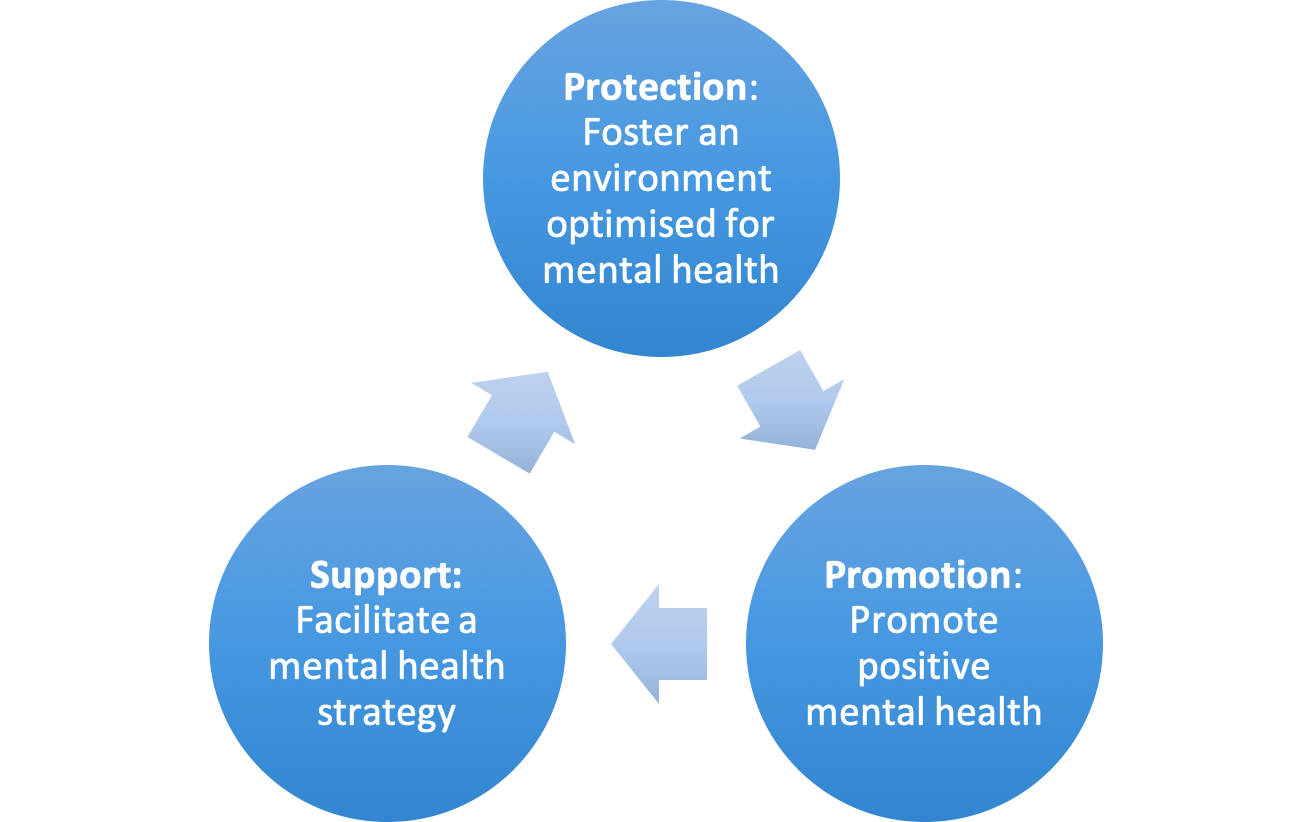The State of Workplace Mental Health in Australia report reveals that one in five Australian workers is currently experiencing a mental health condition and anxiety and depression are the most common of these. With much of people’s time each day spent at work, the workplace is very influential when it comes to mental health and therefore, each employer has a responsibility to maintain a positive and healthy environment that when executed well, will have business benefits too.
With the figures rising year on year, we are at risk of a 'tsunami' of anxious workers if we ignore the impacts of mental health in the workplace. (Kevin Murphy, RMIT)
The Mental Health in the Workplace Organisation Heads Up has some clear steps on how to develop a successful Workplace Mental Health Strategy, the first of which is understanding the concept not as simply the absence of a mental health condition. It is about the presence of wellness, and must be recognised as a continuum from positive, healthy and functioning at one end, to severe symptoms and inability to function at the other. There is a three-pronged approach to the creation of a healthy and positive workplace which can be summarised as follows:

When it comes to defining an effective support and protection strategy for your business, the needs will be different for each case. The first step will be to gain leadership support, and work together on monitoring or understanding the current situation with employee surveys, data collected from absentee rates, illness or injury rates, bullying and harassment reports or claims, staff turnover rates and exit interviews. Once the current needs are understood, it will be easier to identify which areas need improving and which people might be at greater risk.
Let’s look at this 3-step approach as outlined above in a little more detail:
Promotion
Goal: Increase awareness and lobby for the importance of mental health and wellbeing
If positive mental health is seen as a priority amongst the senior leadership team within your organisation – it is more likely that employees will feel it is acceptable to be open and honest about their internal environment.
- Provide information and resources about the signs and symptoms of common mental health conditions and suicide risk, self-care advice, and positive coping strategies.
- Promote related events like R U OK? Day, and World Mental Health Day to affirm mental health and wellbeing as an important part of the workplace and encourage open conversations.
- Focus training and development of managers on positive, proactive leadership tactics like promoting employee strengths, providing constructive feedback and recognition, and matching employee skills and goals with jobs.
- Emphasise the meaningful aspects of work, celebrating achievements and praising efforts as well as results.
- Encourage staff to work together on tasks, discuss ideas, share skills and take part in social activities.
- Promote physical health and healthy eating, educating staff on the link between physical and mental health. Arrange team yoga or meditation classes.
Support
Goal: Support employees living with mental health conditions and combat stigma
Like with any other health condition, mental health should be an accepted part of the conversation between employer and employee around how to work together to manage the condition and what he or she needs to achieve their work goals despite this.
- Develop the capability of leaders and managers through management training, mental health management skills and suicide prevention in the workplace.
- Provide and promote access to a range of external and internal mental health supports (Eg: Welfare staff, grievance officers, “wellbeing champions”, resources from external organisations) Stipulate confidentiality and make the pathways to access clear and open.
- Develop stay-at-work or return-to-work plans for staff who have been diagnosed with a mental health condition regardless of whether it is work-related or not.
- Provide flexibility wherever possible regarding work hours and tasks for people to stay at and return to work, prioritising mental health always.
- Encourage other workers who have had personal experience of mental illness to share their stories in the workplace (a t a staff meeting for example) Ensure that adequate support is provided for the speaker and staff are aware of who to speak to if it brings up issues for them.
Protection
Goal: Foster an anti-bullying culture and address risks and protective factors
By upholding an environment optimised for positive mental health and wellbeing, you are protecting existing workers and educating new staff members to help maintain it. Your situational analysis will have helped to identify a number of risks and individuals who may be at greater risk in the development of mental health conditions which should be specifically addressed, but overall workplace culture risk management must be tackled with a company wide approach.
- Consider the factors that may affect the health and safety of your staff, regularly reviewing and redesigning, including:
- Organisational factors (Role ambiguity and conflict, low levels of support, bullying and lack of communication)
- Operational Factors (Dealing with the public, shift work, longer or unsociable working hours)
- Environmental factors (Unpleasant or dangerous physical conditions like overcrowding or noise/air pollution)
- Individual factors (Conflicting demands of work and home, dealing with stress)
- Empower employees to be mindful of their workload - identifying areas where they could be working smarter by outsourcing or automating some tasks.
- Create awareness of bullying and inappropriate behaviours to break any workplace cultural views that bullying is acceptable.
- Implement confidential reporting and response procedures for when bullying occurs. Ensure policies protect anyone who reports or witnesses workplace bullying from victimisation.
- Ensure that a zero-tolerance policy is widely communicated to staff members.
When it comes to defining a workplace mental health strategy, there will be challenges and resistance. Interest and participation in mental health initiatives will wane, there will be concern about costs to the business for them, there will be people who fear change and beliefs that stress is an accepted part of working life. But when you consider the potential risks of ignoring the issue, and that with every dollar spent on effective mental health initiatives will have on average, a positive return on investment of $2.30, the pros clearly outweigh the cons. Find out how you can use Weploy as part of an effective Workplace Mental Health Strategy by contacting us today.

Even as people venture out into the beginnings of a post-COVID world, remote working has and continues to be the norm. What was once a perk in offices has now become a part of daily working life. There are undeniably numerous benefits, including skipping time-consuming commutes and more flexible hours — a setup that is a dream for employees who want to spend time with families or on other personal endeavours.
However, there are also drawbacks to losing an office environment. Less structured work hours, disconnection from colleagues, and overlapping boundaries that affect work-life balance and wellbeing are some disadvantages. This sudden shift has made wellness more important than ever.

Business as "Unusual"
Shopping centres, restaurants and beaches are filling up again and Australia is preparing to return to work. But the Coronavirus Pandemic has seriously impacted the economy and for most of us, the environment has changed, leaving us with challenges we’ve never experienced before.

TONY: We’ve grown our team substantially at Weploy, from three to 25, and culture is starting to become a big topic. As the senior leadership team, we are trying to figure out what kind of culture we want. Can we influence that? Or is that organic? I’d love to know, what does culture mean to you?
Streamline your hiring
Business support staff with no hidden fees. Start hiring anytime.
